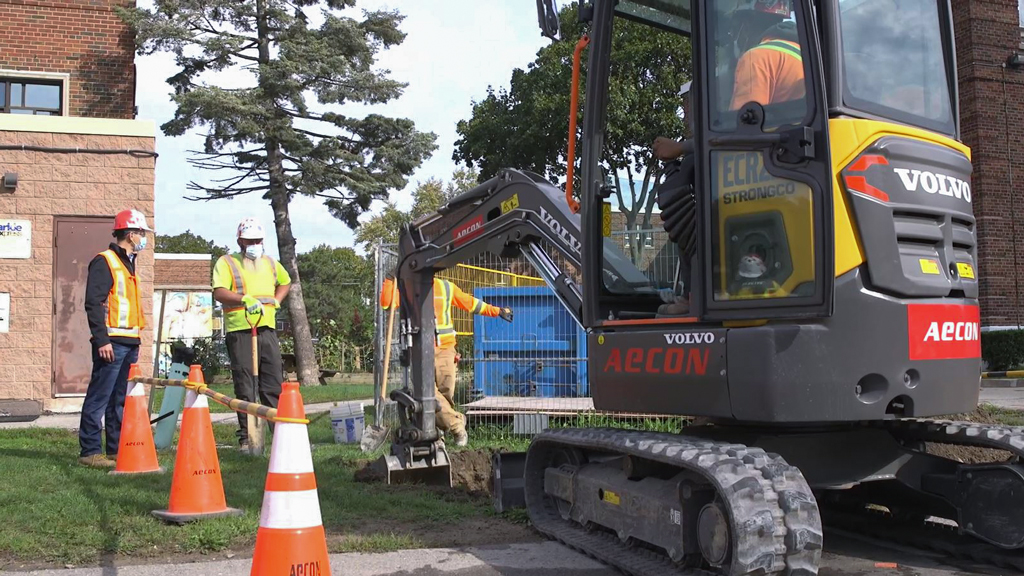Aecon Group’s pilot project to use an electric excavator was something new for the company but also for Canada, marking the first time the equipment was used on an active project site in the country.
The company found the ECR25 electric compact excavator offers the same performance as diesel machines in the same class and is better for the environment.
As part of the pilot, Aecon Utilities used the electric excavator from Volvo Construction Equipment to trench and install new telecommunications conduit and bring fibre optic connectivity to residential buildings in Toronto’s Regent Park community. The electric machine is powered by lithium-ion batteries and produces zero emissions.
“It’s been used in Europe for a little over a year now and this is the first time it’s been available in Canada as a trial,” said Prabh K. Banga, sustainability director with Aecon Group. “It’s currently the only one available in zero emission in its size class. The excavator has a 48 V battery pack which supplies energy to the electric motor. The run time on a full charge is about four to six hours and that totally depends on the types of tasks that are being performed.”
The pilot, which lasted four weeks and ended this month, was a partnership between Aecon, Volvo and Strongco, one of Aecon’s equipment suppliers.
“We spent those four weeks collecting usage data, performance data and we also spoke to our employees about their experience,” said Banga. “Essentially the purpose of the pilot was to get that usage and performance data to see how it integrates into our operations and also in terms of the future, to look at how we can integrate more of this type of equipment.”
In terms of performance, tipping load, hydraulic flow and pressure for hydraulic driven attachments were comparable to diesel-powered machines.
“One of the other things that we noticed is there are additional safety features, very low noise and zero emissions which improves outdoor air quality for our employees…which allows for other applications in the future such as working in noise sensitive areas and potentially indoor use as well,” Banga said.
There are many benefits to using electric equipment.
“When we were trialing Toronto Regent Park the project was happening across the street from a community park. Obviously if there are no emissions coming from that it’s helping with the air quality in and around the area.”
Electric machines also don’t require as much maintenance.
However, “One of the challenges we may see is the ability to charge the equipment, but we see that being addressed in the future with the proliferation of more portable charging facilities,” Banga added.
The project is part of Aecon’s commitment to sustainability, explained Aecon’s chief sustainability officer Yonni Fushman.
In 2020, Aecon became the first construction company in North America to conduct an inventory of all the greenhouse gases (GHG) produced in its operations. Based on that data the company set an emissions reduction target of 30 per cent by 2030 and net-zero by 2050.
“Through that GHG inventory process we learned that our diesel fuel use, which is mostly used in construction equipment, accounts for the highest source of our emissions. That prompted us to reach out to manufacturers around the world, see what technology is available now and what’s coming over the next few years that can help us to reduce those emissions,” said Fushman.
“Improving efficiency is obviously a big part of the emissions reduction strategy but the reality is that we need new technology to get us all the way there and that is where trialing and adopting new technology like this excavator fits in. A lot of this equipment is still new on the market so it’s important for us to trial it onsite, see how it integrates with our operations and also from a cultural change perspective to get people used to working with and around this type of equipment.”
The ECR25 was also trialed in California earlier this year as part of a year-long Volvo CE pilot project. It found based on the combined 400 operating hours of electric machine use, there was a reduction of six metric tons of carbon dioxide emissions and an approximate savings of 560 gallons of fuel when comparing diesel machine use for the same amount of hours.
“It’s exciting to see the momentum growing for electric construction equipment in North America,” said Stephen Roy, president of Region North America, Volvo CE, in a statement. “We are seeing an increasing demand for sustainable solutions as the industry recognizes the importance of acting to reduce climate change.”
Follow the author on Twitter @DCN_Angela.











Recent Comments
comments for this post are closed